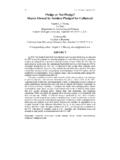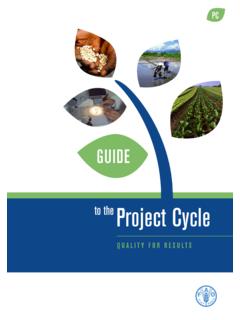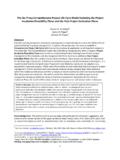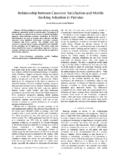Transcription of External Environment Pressure on Organizational Innovation ...
1 External Environment Pressure on Organizational Innovation adoption 99 External Environment Pressure on Organizational Innovation adoption : from Literature to a Conceptual Model LeeAnn Kung* Department of Aviation and Supply Chain Management Auburn University, Auburn, AL Hsiang-Jui Kung Department of Information Systems Georgia Southern University, Statesboro, GA Corresponding Author: ABSTRACT Two research gaps were identified in technology Innovation adoption , namely the rarity of Innovation adoption theory on Organizational and environmental factors.
2 To fill these gaps, we decided to focus our review on the External environmental factors of Organizational Innovation adoption from January 2000 to May 2014. Major theories are presented. An integrated conceptual model is proposed. This review and the proposed conceptual model offer researchers a starting point to examine the External Environment effects on a firm s Innovation adoption decision. In different stages, firms should use different strategy, focus on main issue of that stage, and use different resources to deal with the environmental pressures.
3 Keywords: Innovation adoption , External Environment Pressure , the institutional theory, Product Life Cycle, Technology-Organization- Environment 100 L. Kung & H. Kung INTRODUCTION Many organizations rely on technology Innovation to deal with pressures or reduce uncertainty caused by the turbulent business Environment . Researchers and practitioners have been trying to find out factors that affect Innovation adoption decision. After decades of research, there is still no one set of universal factors of adoption decision since Innovation is relative (Rogers, 2003).
4 However, there are similarities among different models (Makkonen, 2008). While there are different levels of adoption individual, Organizational , and inter- Organizational most adoption literature has focused on individual user s intention, acceptance, and usage of innovations. There are a number of famous and well accepted models of individual adoption , for example, Technology Acceptance Model (TAM), TAM 2, and the theory of planned behavior, but there are few less integrated or comprehensive Innovation adoption models at the organization level.
5 There are not many literature reviews on Innovation adoption and an even smaller number of reviews at the firm level. We only found one review focused on Organizational level during our search period (January 2000 May 2014). Most previous research examined the internal factors, such as Organizational size, slack resources, top management, or technology fit while External environmental factors are not yet fully explored (Citurs and Konsynski, 2007). Agreeing with Joo and Kim (2004) who assert that a comprehensive research model which includes both internal and External factors is often not possible ( ), we decided to focus our review on the External environmental factors of Organizational Innovation adoption from January 2000 to May 2014.
6 This article consists of five sections. The next section states the procedure of literature review. The findings are presented in Section 3. Section 4 discusses major theories. A conceptual model is proposed in Section 5. PROCEDURE Following Webster and Watson (2002), we did searches on Web of Science, ABI/INFORMS and Academic Search Premier databases using keywords " Organizational adoption ", " Organizational Innovation adoption " and "environmental pressures" specifying dates and scholarly articles. We got 14 hits from Web of Science, 6 from ABI/INFORMS and 102 from Academic Search Premier.
7 We also did search on top three IS journals (Management Information Systems Quarterly, Information Systems Research and Journal of Management Information Systems) and 186 articles emerged from January 2000 to May 2014. Table 1 shows the skewed ratios between the number of studies done on Innovation adoption in general and ones done on Organizational level from these three IS journals. We also conducted a citation analysis on Web of Science to see who (influential authors) and what (studies) are cited most by researchers on adoption during January 2000 to May 2014. Most of the top twenty authors presented their model/theory at the individual level.
8 The number one cited model is the Technology Acceptance Model 2 (TAM2). There is only one Organizational level model that appeared among the top ten which is Fudenberg s 1985 study. We then filtered out articles by reading titles, abstracts, and keywords to ensure the articles selected fit our research goal. Twenty two articles were considered suitable for this review: 5 are conceptual, 15 are empirical studies and 2 are literature review. External Environment Pressure on Organizational Innovation adoption 101 Table 1.
9 Number of Articles from three IS Journals Journal adoption adoption + Organization Management Information Systems Quarterly 58 6 Information Systems Research 72 4 Journal of Management Information Systems 56 29 FINDINGS The general conclusion from the literature indicated that, for small businesses, competitive Pressure and imposition by trading partners are the two main sources of External Pressure .
10 However, Penttinen and Tuunainen (2009) find that perceived benefits, supplier Pressure , the bandwagon effect, Organizational readiness, External Pressure from customers are the primary factors. Basaglia, Caporarello, Magni and Pennarola (2009) declare that the policy maker is responsible to make the Environment fertile so as to balance supply and demand. Quoting Mohr (1982), Makkonen (2008) advocate distinguishing between adoption as a decision (variance theory) and process (process theory). His self-reported contributions put an emphasis on change and its acceptance and remind researchers not to ignore the post- adoption phase.








